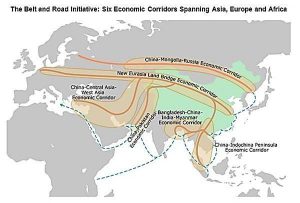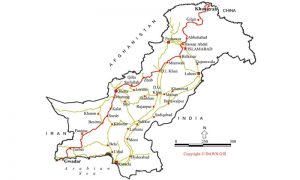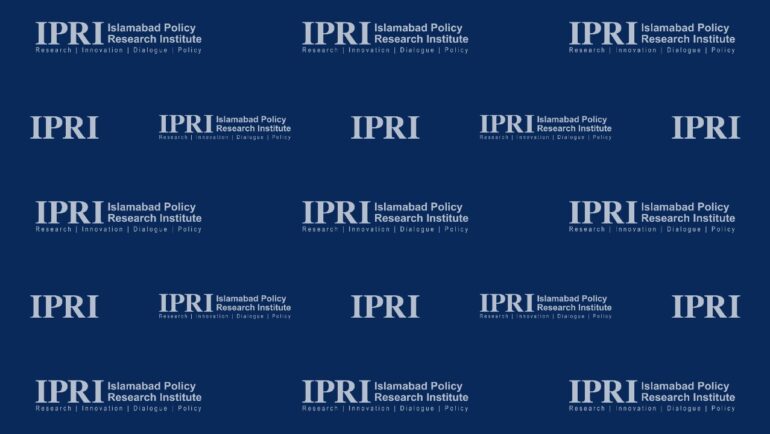

Introduction
An IPRI Review meeting on “Completion of CPEC: Impact on Pakistan’s Strategic Position and Economy” was held at IPRI conference hall on April 26, 2016. China-Pakistan Economic Corridor (CPEC), linking Gwadar to China’s Western city of Kashgar was viewed optimistically. It was reiterated that CPEC would generate economic activity, open vistas and opportunities for Pakistan and the region at large. Further, China’s access to the markets of South Asia and Middle East would be enhanced. The corridor would also diversify China’s energy routes, and lessen the country’s dependence on the Strait of Malacca.
Salient Points
- The salient points of the review meeting are as under:-
- Historically, the very concept of a corridor, has been a cause of development in different parts of the world.[5] In the post-1945 period, European Economic Community was formed (1957). Later, European Union (EU) was created in November 1993.[6] Currently, the free movement of people, goods, services and capital are the pillars of EU. The idea to establish Exclusive Economic Zones (EEZ) comprising Cambodia, Laos, Vietnam and Myanmar under the Greater Mekong Sub-region Economic Cooperation Programme is also akin to the concept of establishing economic corridor for promoting trade and people to people interaction.[7]
- The CPEC will be a channel for the Maritime Silk Route that imagines connecting three billion people in Asia, Africa and Europe.[8] As stated by President Xi Jinping: “The China-Pakistan Economic Corridor is located where the Silk Road Economic Belt and the 21st Century Maritime Silk Road meet.”[9]
- The construction of CPEC would be along the Karakorum Highway build during the 1970s from the Pakistani town of Havalian in Hazara division to Khunjerab Pass, the border of China and Pakistan.[10]
- In 2010, China declared Kasghar, an important transit point on the ancient Silk Route and a gateway between China and Pakistan, as a Special Economic Zone (SEZ) with the idea to develop the Chinese Western province of Xinjiang into a major trading hub leading to energy and economic integration with South and Central Asia. The SEZs in the Pakistani port of Gwadar and Kashgar and the prospects of rail and road connectivity between proposed SEZs would develop great economic, political and strategic potential for the region. The concept of CPEC though started from 2006, was formally presented by Pakistani Prime Minister Nawaz Sharif during his visit to China in November 2014. The two countries signed 19 agreements and Memorandum of Understanding (MoU) to boost the bilateral ties between China and Pakistan in various fields including energy and basic infrastructure sectors.[11]
- CPEC is equally beneficial to China. The port of Shanghai is 10,000 kilometres from the Strait of Hormuz by sea via the Malacca route while Kashgar, the capital of Xinjiang, is about 4500 kilometres from the port of Shanghai. However, Kashgar is 2800 kilometres from Gwadar via the envisaged CPEC and hence just over 3400 kilometres from the Strait of Hormuz. It makes plain economic sense for Beijing to prefer this route only on the basis of the time distance equation. However, besides economy China also faces security issues which make the Gwadar-Kashgar route important. The ships travelling from the Persian Gulf or the Red Sea have to pass close to the Indian territory as well as through the Malacca Strait. China is fully aware of the vulnerability of the ships throughout the long sea passage and particularly through the Malacca which is termed by the Chinese as the “Malacca Dilemma”. China is, therefore, looking for alternative options to safeguard its supplies and Gwadar provides the most secure and economically feasible alternative to link with this side of the world.[12]
- The four main pillars of CPEC are Gwadar port, communication infrastructure, energy infrastructure and industrial zones.[13]
- China has made commitment to invest around US $ 46 billion in the developmental projects[14] (which is roughly 20 percent of Pakistan’s annual GDP, with approximately US $ 28 billion in immediate projects and the rest allocated for projects in the pipeline).[15] In total, the energy projects will add 17,000 megawatts of electricity generation at a cost of US $ 34 billion.[16] The rest of the money will be spent on transport infrastructure, including upgrading the railway line between the port megacity of Karachi and Peshawar.[17]. Major infrastructural projects to be constructed under the CPEC include Gwadar East Bay Expressway, Gwadar International airport, up-gradation of KKH phase-II, parts of Karachi–Lahore Motorway and Muzaffarabad–Mirpur Expressway.
- The amount spent on the projects will be in the form of concessional loans, mainly from Chinese banks to Chinese companies for specific projects. These projects will take three to fifteen years to complete. Chinese engineers, technicians and labour will come to Pakistan for construction of these projects. The Pakistan’s Army (principally the Frontier Works Organization) and civilian personnel will also be working on some of these projects.[18]
- CPEC – Routes[19]. There are three routes of the CPEC after it enters Khyber-Pakhtunkhwa from the Khunjerab Pass and Gilgit-Baltistan:-
- The first (Western) route suggests that the CPEC will enter Balochistan via Dera Ismail Khan to Zhob, Qila Saifullah, Quetta, Kalat, Punjgur, Turbet and Gwadar.
- The second (Central) route goes from Dera Ismail Khan to Dera Ghazi Khan and onwards to Dera Murad Jamali, Khuzdar, Punjgur, Turbet to Gwadar.
- The third route (Eastern) enters the Punjab province from Khyber Pakhtunkhwa, going through Lahore, Multan and Sukkur, from there it takes the traditional highway to enter Balochistan, passing through Khuzdar, Punjgur, Turbet and Gwadar.
- An alternate route will go from Sukkur to Karachi and from there take the coastal highway to Gwadar. The first route is the shortest of the three routes. It will pass through very underdeveloped areas (that have security problems). The third route (Eastern) is already functional, and requires upgrading.
- CPEC and Pakistan’s Regional Standing
- The regional states can increase their mutual relevance and build a cooperative and positive environment by engaging in greater economic activity, especially trade cooperation. Pakistan, located at the crossroads of resource rich Central and West Asia, the Persian Gulf and the oil rich Middle East holds a strategic position. But, due to the factors like volatile geopolitics, inadequate transportation systems and energy shortage, Pakistani economy has remained short of using its full potential. With the implementation of CPEC, Pakistan will be able to enhance its strategic importance. CPEC would link South Asia, Central Asia, North Africa and Gulf states with economic and energy cooperation ties. Pakistan’s Ambassador to China Masood Khalid said: “The territory of Pakistan is like a corridor which connects China and Arabian Sea and Pakistan is a bridge between China and the world.”[20]
- The Gwadar Port located at the Arabian sea (72 kilometres from Iran; about 320 kilometres from Cape al-Hadd in Oman and about 400 kilometres from the Strait of Hormuz and linked with Persian Gulf), has the capacity of handling up to 19 million tons of crude oil per year, after putting the required infrastructure in place.[21] Through the construction of CPEC, China is interested in developing a direct crude oil pipeline from Gwadar to Xinjiang.[22]
- With the development of Gwadar Port, all trade to and from Central Asian Republics (CARs) is going to adopt the shortest available route via Gwadar and the trade benefits to Pakistan are expected to multiply. Pakistan could become a major world channel for petro-chemical trade and greatly stimulate its economic growth.[23] Moreover, the province of Balochistan will become significant for regional integration.[24]
- It is also expected that the corridor will link with India and Afghanistan.[25] However, India has been skeptical about the Belt and Road initiative, as India does not wish to see China expand its influence in South Asia, nor the formation of a second pole of influence in South Asia,[26] which could be a threat to its economy. India has raised objections to the planned corridor for passing through Gilgit-Baltistan.[27] To counter Chinese moves, India has also announced to invest US $ 100 million in the development of Iranian Chabahar port, which they believe will be a means to reach Afghanistan and Central Asia without having to rely on Pakistan.
- CPEC and Pakistan’s Economy
- According to Minister for Planning Development and Reform Ahsan Iqbal, “Pakistan-China Economic Corridor is not the name of a single route or alignment, it is a comprehensive package of cooperative initiatives and projects encompassing regional connectivity, information network infrastructure, energy cooperation, industry and industrial parks, agricultural development, and poverty alleviation, financial cooperation as well as livelihood improvement including municipal infrastructure, education, public health and people-to-people communication which will result in thousands of new ventures and millions of jobs in every part of Pakistan.”[28]
- The Asian Development Bank has termed the project as, “CPEC will connect economic agents along a defined geography. It will provide connection between economic nodes or hubs, centered on urban landscapes, in which large amount of economic resources and actors are concentrated. They link the supply and demand sides of markets.”[29]
- Pakistan is the second largest trading partner of China in South Asia; the trade volume stands at US $ 19 billion.[30] According to data released by the State Bank of Pakistan, the country received US $ 975.4 million as FDI during July-March 2015/16 as compared to the US $ 832.2 million in the corresponding period of last fiscal year.[31] The FDI from China grew by 167 percent to US $ 516 million during July-March 2015/16 as compared to the US $ 193.3 million in the corresponding period of the last fiscal year.[32]
- The CPEC would pass through all the four provinces as well as Gilgit-Baltistan. Balochistan and KPK’s backward areas would be developed. Balochistan is rich in mineral resources (estimated stock of 200 million tons of iron and 217 million tons of coal, Saindak gold and copper mines contain reserves up to 412 million tons of copper and gold, Reko Dik 5.9 billion tons of copper and gold).[33] The mining sector would flourish. It would contribute towards reducing unemployment in local areas; strengthening micro, medium and small sized industries, thus, benefiting the local population.
- Federal Minister for Planning Development and Reforms, Ahsan Iqbal said: “The production of 10,000 megawatts of energy under the CPEC would help overcome the energy crisis by 2018 as well as upgrade the existing road network of the country.”[34]
- Universities are also being planned on CPEC’s Western route.[35] These universities will educate and empower the people of FATA, Zhob and Gwadar. Tourism will also flourish under CPEC.
Major Conclusions
- The construction of CPEC is an important consensus reached by the leaders of China and Pakistan. It will optimize the trade and energy cooperation between China and Pakistan and benefit over three billion people in China, South Asia and Middle East.
- CPEC realizes the new realities of global and regional politics by cultivating a more systematic, up-graded and need-based interaction for socio-economic, industrial, energy and trade development.[36]
- Pakistan’s leadership describes the CPEC as a game changer for Pakistan and the region at large.[37] However, the dividends of CPEC will be realized over a period of 10-15 years. It therefore requires a continued determination on part of China and Pakistan to stay firm on the course.[38]
- It is important to make sure that all Memorandums of Understandings (MoUs) and any new policy arrangements that may be agreed to in the future by China and Pakistan, are implemented in their true spirit without any delay.
- A strict scrutiny of the performance and quality of work on different projects will be needed. Similarly, safeguards are needed against corruption. The creation of Prime Minister’s Delivery Unit (PMDU) in April 2015 to monitor the implementation of the projects under the CPEC is a positive move.[39]
- Pakistan will have to provide security to engineers, technicians and labour that will work on the corridor projects. In April 2015, the Pakistan Army announced establishment of a special security division, headed by a Major General, for providing security. This special security division comprises nine Army battalions and six wings of paramilitary forces (Rangers and Frontier Corps), numbering around 10,000 personnel.[40]
- The CPEC project will transform Pakistan’s geographic location into an asset. The business community and private sector needs to come forward, and play their role in making CPEC a success.[41]
- CPEC will ease Pakistan’s energy crisis while connecting the country’s economy with its neighbours on three sides, the east, north and the west. India is the only missing link in the Belt and Road project. It raised objections to the planned construction of the Corridor through Gilgit-Baltistan.
- China’s engagement with Pakistan gives an opportunity to counter-balance the Indian-US strategic partnership.[42] The anti-state elements opposing construction of the corridor may try to misguide the local people of Balochistan, Khyber Pakhtunkhwa and Gilgit-Baltistan.
- Extremist/ethnic elements could also be exploited to sabotage construction of CPEC. Meanwhile, the East Turkistan Islamic Movement (ETIM) in Xinjiang may also create problems.[43] To counter these disgruntled elements and to thwart the hidden nefarious agendas, the government needs to employ a multi-dimensional strategy encompassing both soft and hard power. A Pakistan-China joint counter terrorism mechanism is required.
- The role of think tanks, media and educational exchanges will also be useful in allaying the negative perceptions and apprehensions over the CPEC project.
[1] Shahnawaz Akhter, “FDI up 15pc on CPEC Inflows in July-March”, The News, April 19, 2016.
[2] Ibid.
[3] Mir Sherbaz Khetran, “The Potential and Prospects of Gwadar Port”, Institute of Strategic Studies Islamabad (ISSI) Journal, Vol. 34 and 35, No. 4 and 1, (Winter 2014 and Summer 2015): 73, (accessed April 10, 2016), http://issi.org.pk/wp-content/uploads/2015/12/Sherbaz_3435_SS_41_20142015.pdf.
[4] Ibid, p. 85.
[5] Dr. Moonis Ahmar, “Strategic Meaning of the China-Pakistan Economic Corridor”, Institute of Strategic Studies Islamabad (ISSI) Journal, Vol. 34 and 35, No. 4 and 1, (Winter 2014 and Summer 2015): 38, (accessed April 5, 2016), http://issi.org.pk/wp-content/uploads/2015/12/Moonis-Ahmar_3435_SS_41_20142015.pdf.
[6] Ibid, 38 and 39.
[7] Ibid.
[8] Muhammad Saqib Irshad, Qi Xin and Hamza Arshad, “One Belt and One Road: Does China-Pakistan Economic Corridor Benefit for Pakistan’s Economy”, Journal of Economics and Sustainable Development, Vol.6, No. 24, (2015): 203.
[9] Dr. Hasan Askari Rizvi, “The China-Pakistan Economic Corridor: Regional Cooperation and Socio-Economic Development”, Institute of Strategic Studies Islamabad (ISSI) Journal, Vol. 34 and 35, No. 4 and 1, (Winter 2014 and Summer 2015): 10, (accessed April 5, 2016), http://issi.org.pk/wp-content/uploads/2015/12/Hasan-Askari-Rizvi_3435_SS_41_20142015.pdf.
[10] Dr. Moonis Ahmar, “Strategic Meaning of the China-Pakistan Economic Corridor”, p. 42, http://issi.org.pk/wp-content/uploads/2015/12/Moonis-Ahmar_3435_SS_41_20142015.pdf.
[11] Ibid.
[12] Dr. Azhar Ahmad, “Gwadar Port Potential and Prospects”, Research Paper, Pakistan Institute for Conflict and Security Studies (PICSS), http://www.picss.net.
[13] Dr. Hasan Askari Rizvi, “The China-Pakistan Economic Corridor: Regional Cooperation and Socio-Economic Development”, p. 10, http://issi.org.pk/wp-content/uploads/2015/12/Hasan-Askari-Rizvi_3435_SS_41_20142015.pdf.
[14] Muhammad Saqib Irshad, “One Belt and One Road: Does China-Pakistan Economic Corridor Benefit for Pakistan’s Economy”, p. 202.
[15] Ibid.
[16] Ibid.
[17] Muhammad Saqib Irshad, “One Belt and One Road: Does China-Pakistan Economic Corridor Benefit for Pakistan’s Economy”, p. 203.
[18] Dr. Hasan Askari Rizvi, “The China-Pakistan Economic Corridor: Regional Cooperation and Socio-Economic Development”, p. 11, http://issi.org.pk/wp-content/uploads/2015/12/Hasan-Askari Rizvi_3435_SS_41_20142015.pdf.
[19] Ibid, 10.
[20] “One Belt One Road Provides New Drive for Regional Sustainable Development”, People’s Daily, April 8, 2016, (accessed April 11, 2016), http://en.people.cn/n3/2016/0408/c90000-9041876.html.
[21] Dr. Simrit Kahlon, “Gwadar port Operationalisation: India, US Need to Redraw Maritime Strategy”, Indian Defence Review, April 16, 2015, (accessed May 9, 2016), http://www.indiandefencereview.com/spotlights/gwadar-port-operationalisation-india-us-need-to-redraw-maritime-strategy/.
[22] Mir Sherbaz Khetran, “The Potential and Prospects of Gwadar Port”, Institute of Strategic Studies Islamabad (ISSI) Journal, Vol. 34 and 35, No. 4 and 1, (Winter 2014 and Summer 2015): 82, (accessed April 10, 2016), http://issi.org.pk/wp-content/uploads/2015/12/Sherbaz_3435_SS_41_20142015.pdf.
[23] Ibid, pp. 75-78.
[24] “3 Varsities on CPEC Route to be Functional this Year: Ahsan”, The News, March 15, 2016.
[25] Muhammad Saqib Irshad, “One Belt and One Road: Does China-Pakistan Economic Corridor Benefit for Pakistan’s Economy”, p. 204.
[26] Shafei Moiz Hali, Dr. Tan Shukui and Sumera Iqbal, “One Belt and One Road: Impact on China-Pakistan Economic Corridor”, Institute of Strategic Studies Islamabad (ISSI) Journal, Vol. 34 and 35, No. 4 and 1, (Winter 2014 and Summer 2015):158, (accessed April 10, 2016), http://issi.org.pk/wp-content/uploads/2015/12/Shafei_Moiz_and_Tan_and_Sumera_3435_SS_41_20142015.pdf.
[27] Dr. Hasan Askari Rizvi, “The China-Pakistan Economic Corridor: Regional Cooperation and Socio-Economic Development”, p. 13, http://issi.org.pk/wp-content/uploads/2015/12/Hasan-Askari-Rizvi_3435_SS_41_20142015.pdf.
[28] Dr. Moonis Ahmar, “Strategic Meaning of the China-Pakistan Economic Corridor”, p. 42, http://issi.org.pk/wp-content/uploads/2015/12/Moonis-Ahmar_3435_SS_41_20142015.pdf.
[29] Ibid, p. 39.
[30] Obaid Abrar Khan, Pakistan 2nd Largest Trading Partner of China: Envoy, The News, March 10, 2016.
[31] Shahnawaz Akhter, “FDI up 15pc on CPEC Inflows in July-March”, The News, April 19, 2016.
[32] Ibid.
[33] Dr. Azhar Ahmad, “Gwadar Port Potential and Prospects”, Research Paper, Pakistan Institute for Conflict and Security Studies (PICSS), http://www.picss.net.
[34] “CPEC’s First Phase to be Completed by 2018”, The News, April 17, 2016.
[35] “3 Varsities on CPEC Route to be Functional this Year: Ahsan”, The News, March 15, 2016.
[36] Dr. Hasan Askari Rizvi, “The China-Pakistan Economic Corridor: Regional Cooperation and Socio-Economic Development”, p. 12, http://issi.org.pk/wp-content/uploads/2015/12/Hasan-Askari-Rizvi_3435_SS_41_20142015.pdf.
[37] China Closely Works with Pakistan to Implement CPEC, The News, March 19, 2016.
[38] Dr. Hasan Askari Rizvi, “The China-Pakistan Economic Corridor: Regional Cooperation and Socio-Economic Development”, p. 12, http://issi.org.pk/wp-content/uploads/2015/12/Hasan-Askari-Rizvi_3435_SS_41_20142015.pdf.
[39] Ibid.
[40] Ibid, p. 13.
[41] Mansoor Ahmad, CPEC May Help China Play Role of Large Economy in Region, The News, March 20, 2016.
[42] Mir Sherbaz Khetran, “The Potential and Prospects of Gwadar Port”, Institute of Strategic Studies Islamabad (ISSI), Institute of Strategic Studies Islamabad (ISSI) Journal, Vol. 34 and 35, No. 4 and 1, (Winter 2014 and Summer 2015): 73, (accessed April 10, 2016), http://issi.org.pk/wp-content/uploads/2015/12/Sherbaz_3435_SS_41_20142015.pdf.
[43] Ibid, p. 85.

